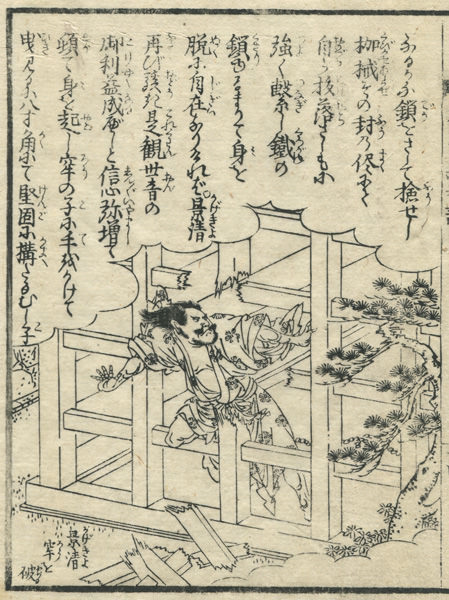It is an illustration about explanation of “設復有人若有罪若無罪枷械枷鎖検繋其身称観世音菩薩名者皆悉断壊即得解脱(setubuunin-nyakumuzai-tyuukaikasakengeigosin-syoukanzeonbosatu-myousyakaisitudanne-sokutokugedatu).” The title of an illustration is “Kagekiyo breaks a prison.”
It is written about misfortune in which it is caught by avarice which is one of the seven misfortune. In the first half, although description of this sutra is written, the first “設復有人若有罪若無罪” is interesting.
As well as guilt, even if it is innocence, it is written that those with は and both can acquire the divine protection of the Kannon to be tied to a chain.
Probably, far old Japan and situation have not changed, since there is relief by a false charge or the judicial system even now.
Then, the following is the free translation of the portion about an illustration.
The 藤原景清(Fujiwara kagekiyo) which is “Heike’s samurai and was called “bad 7 Hyoe” was.
Even after believing in the Goddess of Mercy of Kiyomizu-dera in Kyoto and ruining the Heike family, the body was hidden in the country in Owari.
However, Yoritomo Minamotono who is an enemy hears that the Great Buddha mass for the dead is carried out, and it tries to shoot Heike’s enmity.
It is caught by the private soldier of defense at last it was questioned by Shigetada Hatakeyama, although it was disguised and it was wandering about it and wandering around Todaiji.
After catching, also in Heike, especially, it will turn out that it is brave Kagekiyo, even not only restraint but a chain will be attached, and it will be tied in prison.
“My fortune of war does not plan to blame whom but until now, either.
It presupposed that it is hoped 罪障 (deed which obstructs a peaceful death) disappears”, and prayed for the Goddess of Mercy of Kiyomizu-dera.
Reciting 普門品 (Fumonbon) constantly, after being tied in a prison, the number of times already exceeds 3000 times. ”
“Light shone in and came at a certain night.
When it looks around the outside of a surprise prison, purple clouds of Kagekiyo can be seen.
The Goddess of Mercy stood into it, emitting light.
Kagekiyo prayed with its hands joined and worshipped the hand, calling the name of the Kannon, when it was kind.
Then, he awakes and it gets to know that it was a dream.
Although disappointed with whether it was a dream, it escaped from restraint automatically to the wonderful thing, and the chain was able to loosen and it was able to slip out of it.
Kagekiyo is surprised again, and if this is the divine favor of the Goddess of Mercy, it will strengthen piety more.
It rises and pushes down on the lattice of a prison, applying a hand.
Even if the lattice which must have been made strongly did not put in power, it broke, and it has escaped from it easily.
The Watch sleeps soundly and does not notice.
Nobody was noticed but it escaped from the plight at last. ”
「設復有人若有罪若無罪枷械枷鎖検繋其身称観世音菩薩名者皆悉断壊即得解脱」の説明に関する挿絵です。挿絵のタイトルは「景清 牢を破る」です。
七難(火難/水難/風難/刀杖難/鬼難/枷鎖難/怨賊難)の中の1つ、枷鎖難について書かれています。前半には、この経文の解説が書かれていますが、興味深いのは最初の「設復有人若有罪若無罪」です。有罪はもちろん、無罪であっても鎖に繋がれることがはあり、どちらも観音の加護を得ることができると書かれています。現在でも冤罪や司法制度による救済がありますから、遠い昔の日本と状況は変わっていないのでしょう。
それでは、以下が挿絵に関する部分の意訳です。
「平家の侍であり「悪七兵衛」と言われた藤原景清がいた。京都の清水寺の観世音を信仰し、平家一族が滅んだ後も、尾張の国に身を潜めていた。しかし、仇敵である源頼朝が大仏供養をすると聞き、平家の仇を討とうとする。変装をして東大寺のあたりを徘徊していたが、畠山重忠に見咎められた末に警備の兵卒に捕らえられる。捕らえた後に、平家の中でも特に勇猛な景清だとわかり、枷だけでなく鎖まで付けられて獄中に繋がれてしまう。『我が武運もこれまでだが、誰を恨むつもりもない。罪障(成仏の障害になる行い)が消えるのを願う』とし、清水寺の観世音菩薩を祈念した。牢内に繋がれてから日夜普門品(ふもんぼん)を唱え、その回数は既に3000回を超える。」
「ある夜に、光が差し込んで来た。景清は驚き牢の外を見回すと、紫の雲が見える。その中には、観世音菩薩が光を放って立っていた。景清はありがたいことだと観音の名を呼びながら手を合わせて拝んだ。すると、目が覚めて夢であったのだと知る。夢だったのかと落胆するが、不思議なことに枷は自然に抜けて鎖は緩んで抜け出すことが出来た。景清はまた驚き、これは観世音のご利益だと信心をより強める。身を起こし、牢の格子に手をかけて引倒す。堅固に作られていたはずの格子は力を入れずとも壊れ、簡単に脱出できた。牢番は熟睡して気づかない。見咎める者もなく、ついに窮地を脱した。」

